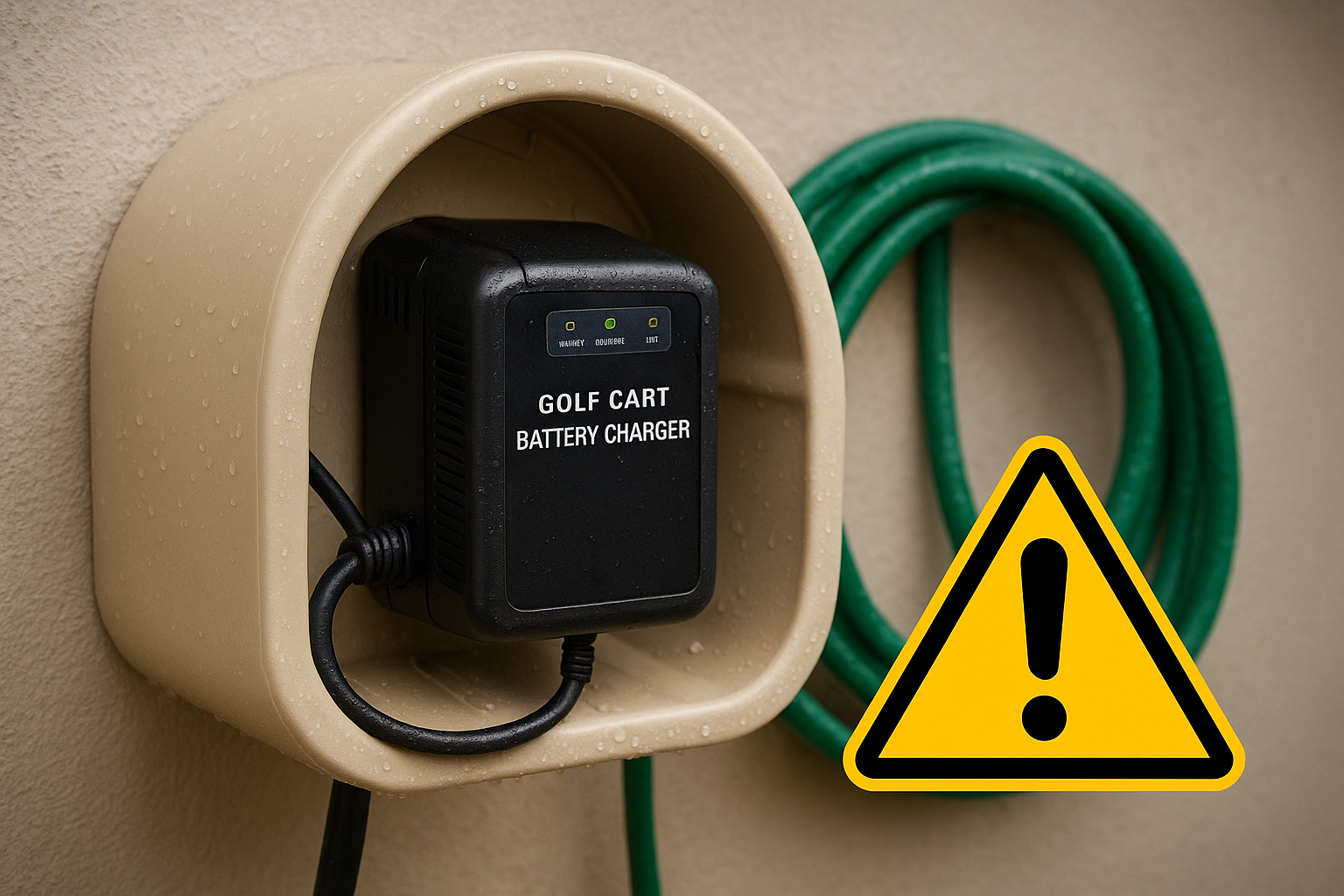-
Shopping Tools
-
Care & Maintenance
-
About
-
Dealer Login

Storing a golf cart charger in a hose mount is not recommended due to the potential risks of water damage, overheating, and fire hazards. While some chargers may be waterproof, many are not, and the confined space of a hose mount is not an ideal environment for any electronic device.
Golf cart chargers are designed to be kept in dry, cool environments. While it may seem convenient to store a charger in a hose mount, doing so can create several risks that may damage the charger, the golf cart's battery system, and even pose a fire hazard. Below are the key reasons why storing a golf cart charger in a hose mount is unsafe:
One of the main concerns when storing a golf cart charger in a hose mount is the risk of water exposure. Even if your charger is marked as waterproof, it’s still best to avoid storing it in places where water can accumulate or where it can be exposed to moisture. A hose mount, especially if it is outdoors, is likely to be exposed to rain or water from the hose. Water exposure to a golf cart charger can cause short circuits, rust, and irreversible damage to internal components. This could compromise the charger’s ability to function properly, leading to potential failure or even safety hazards like electric shocks.
Golf cart chargers are designed to be used in well-ventilated spaces. When charging, these devices can generate heat. A confined, enclosed space, like a hose mount, limits airflow around the charger, which can cause it to overheat. Prolonged overheating can damage the charger and reduce its lifespan, but more importantly, it can pose a fire hazard. Overheated chargers can become a serious risk if left unattended or stored improperly, especially in confined spaces with limited ventilation.
Overheating due to poor ventilation can lead to dangerous situations, including the risk of fire. Even if the charger itself doesn’t catch fire, excessive heat can cause other nearby materials in the confined space to ignite. Fire hazards are especially concerning when dealing with electrical devices, as sparks or heat can trigger fires, particularly when flammable materials like plastic or dry leaves are nearby. The risk is even greater in areas where the charger is not monitored or easily accessible.
To ensure the longevity and safety of your golf cart charger, it’s important to store it in the right environment. Here are some tips for proper storage:
Always store your charger in a dry and cool place. Avoid places like garages or areas where humidity levels may fluctuate or where there is a risk of water exposure. A dry storage space ensures that the charger’s internal components stay safe from corrosion and other moisture-related issues. Additionally, keeping it in a cool area helps maintain the charger’s performance and prevents overheating.
Ensure that the storage space for the charger is well-ventilated. Chargers generate heat during use, so they need a location where air can circulate freely. This helps to dissipate the heat and ensures that the charger does not overheat. Avoid storing the charger in cabinets or tight spaces without proper airflow.
It’s also a good idea to store your golf cart charger off the floor, especially if you are storing it in a garage or shed. This helps prevent exposure to dirt, moisture, or water that may accumulate on the floor. Storing the charger on a shelf or a dedicated charging station is a safer option.
Yes, golf cart chargers do need ventilation to function properly and safely. As mentioned earlier, during the charging process, these devices generate heat. If the charger is placed in a space without adequate airflow, it can overheat, leading to performance issues, reduced efficiency, and potential damage to both the charger and the golf cart battery. Proper ventilation ensures that the charger operates within the recommended temperature range, preventing any long-term damage and maintaining safe operation.
It’s generally not a good idea to leave a golf cart charger plugged in all the time unless you are using a smart charger that has an automatic shut-off feature once the battery is fully charged. Overcharging can cause the battery to degrade over time, reducing its lifespan and efficiency. Most modern chargers are designed with built-in mechanisms to stop charging once the battery reaches full capacity, but if you’re using an older charger or if you’re unsure about your charger’s features, it’s best to unplug the charger once the golf cart battery is fully charged. Regularly unplugging the charger can help prevent damage and conserve energy.
While it may seem convenient to store your golf cart charger in a hose mount, it is not a safe or practical solution. The risks of water damage, overheating, and potential fire hazards outweigh the benefits of such storage. To ensure your charger’s longevity and proper functioning, always store it in a dry, cool, well-ventilated space.
